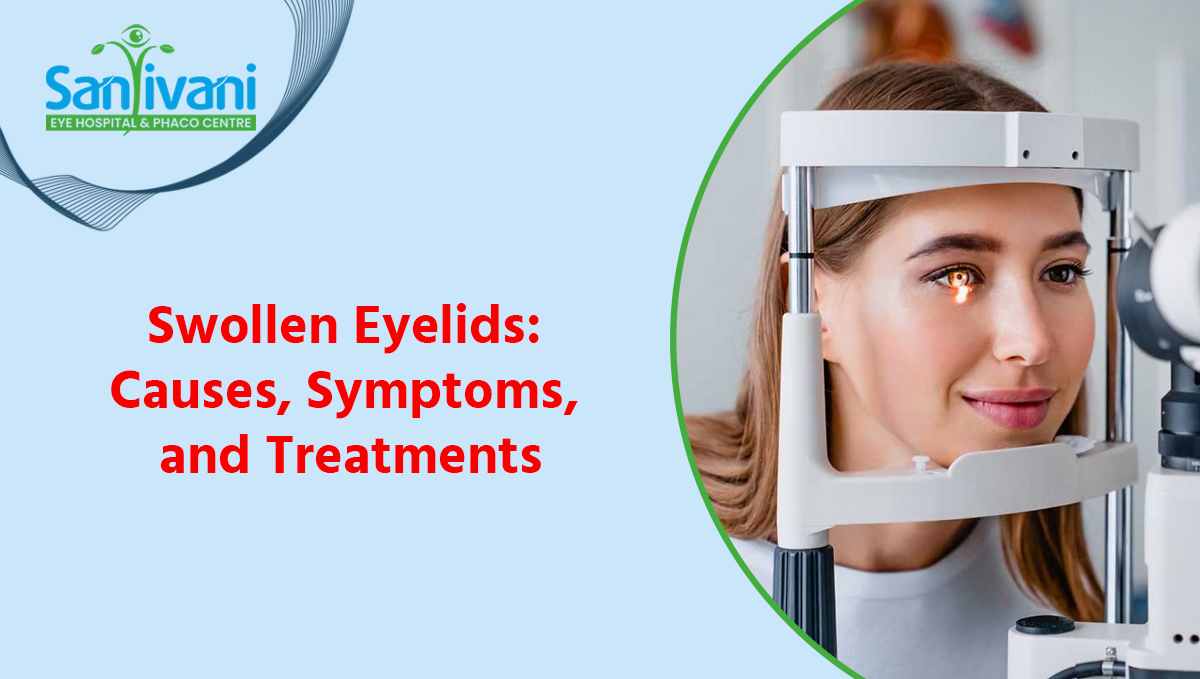
Swollen Eyelids: Causes, Symptoms, and Treatments
Swollen eyelids are a common yet distressing condition that can affect one or both eyes. They can be caused by a range of factors, from minor irritants to more serious underlying health issues. This blog will explore the various causes of swollen eyelids, their symptoms, and the available treatments to help manage and alleviate this uncomfortable condition.
Understanding Swollen Eyelids
Swollen eyelids occur when there is an accumulation of fluid in the tissues surrounding the eyes. This swelling, also known as periorbital edema, can be localized to just one eyelid or affect both. It may appear suddenly or develop gradually, and its severity can range from mild puffiness to severe bulging.
Common Causes of Swollen Eyelids
1. Allergies:
Allergic reactions are a leading cause of eyelid swelling. Common allergens include pollen, dust mites, pet dander, and certain cosmetics. Allergic conjunctivitis, where the lining of the eyes and eyelids becomes inflamed, often results in red, itchy, and swollen eyelids.
2. Infections :
Infections can cause inflammation and swelling of the eyelids. Some common infections include:
- Blepharitis : Inflammation of the eyelid margins due to bacterial infection or seborrheic dermatitis. Symptoms include redness, itching, and crusting.
- Conjunctivitis (Pink Eye) : An infection of the conjunctiva, the thin membrane covering the eye and inner eyelid. It can be viral, bacterial, or allergic.
- Chalazion and Stye : A chalazion is a blocked meibomian gland that causes a firm, painless lump, while a stye is a painful, red, and swollen bump on the eyelid.
3. Injuries :
Trauma or injuries to the eye area, such as scratches or blows, can lead to swelling. This may also include orbital fractures or bruising from accidents.
4. Sinusitis :
Inflammation or infection of the sinuses can cause swelling around the eyes. Sinusitis often leads to puffiness due to fluid retention and congestion.
5. Fluid Retention :
Conditions that cause the body to retain fluids, such as heart or kidney issues, can lead to general swelling, including around the eyes. This is often seen in the morning and improves throughout the day.
6. Systemic Conditions :
Some systemic health issues, like thyroid disorders (e.g., Graves' disease) or kidney problems, can lead to persistent eyelid swelling.
7. Aging :
As we age, the skin around the eyes loses elasticity, and fat deposits can accumulate, causing the appearance of puffiness or bags under the eyes.
Symptoms Accompanying Swollen Eyelids
The symptoms associated with swollen eyelids can vary depending on the underlying cause:
- Redness : Often seen with infections or allergic reactions.
- Itching or Burning : Common in allergic reactions and infections.
- Pain or Tenderness : Typically associated with styes, chalazion, or injuries.
- Discharge : In cases of conjunctivitis or infections, there may be a discharge from the eyes.
- Vision Changes : Although less common, severe swelling may affect vision or cause discomfort.
Diagnosis and When to See a Doctor
Diagnosis typically involves a thorough examination by an eye care professional or general practitioner. They may ask about your medical history, conduct a physical examination, and possibly perform additional tests to determine the cause of the swelling.
Seek medical attention if you experience:
- Persistent or worsening swelling despite treatment.
- Severe pain, vision changes, or sensitivity to light.
- Signs of a serious infection, such as fever or swollen lymph nodes.
- Recent trauma to the eye or face.
Treatment Options for Swollen Eyelids
Treatment for swollen eyelids depends on the underlying cause:
- Antihistamines : Over-the-counter or prescribed medications can help reduce allergic reactions.
- Cold Compresses : Applying a cold, damp cloth to the eyes can reduce swelling and relieve discomfort.
1. Allergy Relief :
- Antibiotics or Antiviral Medications : Prescribed by a doctor for bacterial or viral infections.
- Warm Compresses : Beneficial for treating styes and chalazions, helping to ease discomfort and promote drainage.
- Proper Eyelid Hygiene : Cleaning the eyelid margins gently with mild, non-irritating solutions can help manage blepharitis.
2. Infection Management :
- Cold Compresses : Applying a cold compress can help reduce swelling and bruising.
- Pain Relief : Over-the-counter pain relievers may alleviate discomfort.
3. Injury Care :
- Elevate Your Head : When sleeping, keeping your head elevated can help reduce fluid accumulation.
- Monitor Diet : Reducing salt intake and maintaining a healthy diet can assist with fluid retention.
4. Fluid Retention :
- Medical Management : Treating the underlying systemic condition with appropriate medical care.
5. Addressing Systemic Conditions :
- Eye Creams and Gels : Specialized products containing ingredients like caffeine or retinol can help reduce puffiness.
- Lifestyle Changes : Ensuring adequate sleep, hydration, and managing stress can contribute to reducing eye puffiness.
6. Cosmetic and Aging-Related Puffiness :
Prevention Tips
- Avoid Allergens : Identify and avoid known allergens. Use hypoallergenic products if necessary.
- Practice Good Hygiene : Clean your face and eyes regularly and avoid touching your eyes with dirty hands.
- Protect Your Eyes : Wear protective eyewear to prevent injuries.
- Stay Hydrated and Eat Well : Maintain a balanced diet and adequate water intake to support overall health.
Conclusion
Swollen eyelids can be uncomfortable and concerning, but understanding the potential causes and symptoms can help in managing the condition effectively. Whether due to allergies, infections, or systemic issues, proper diagnosis and treatment are crucial for alleviating symptoms and preventing recurrence. If in doubt, consulting with a healthcare professional will ensure you receive the appropriate care for your specific situation.